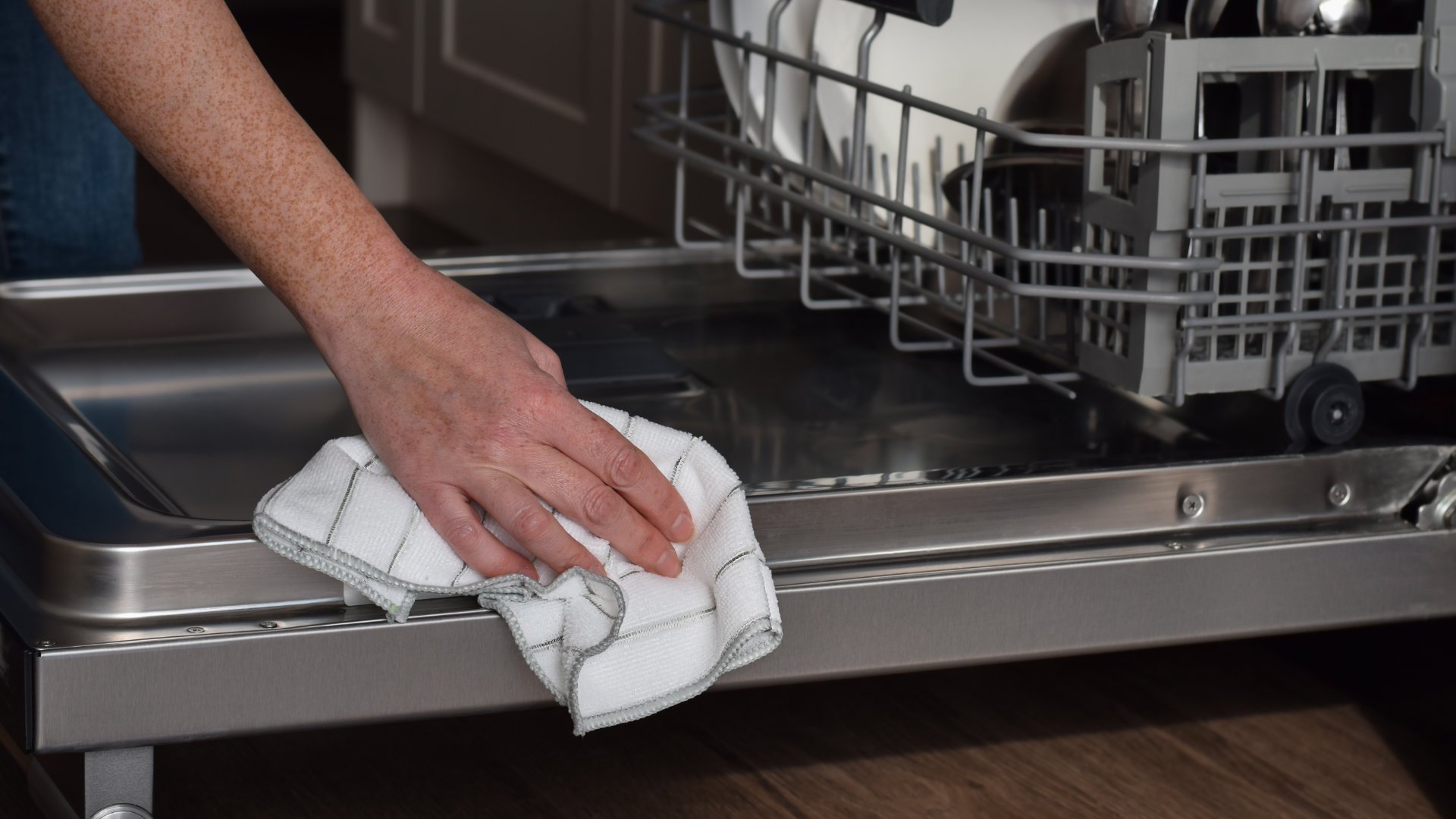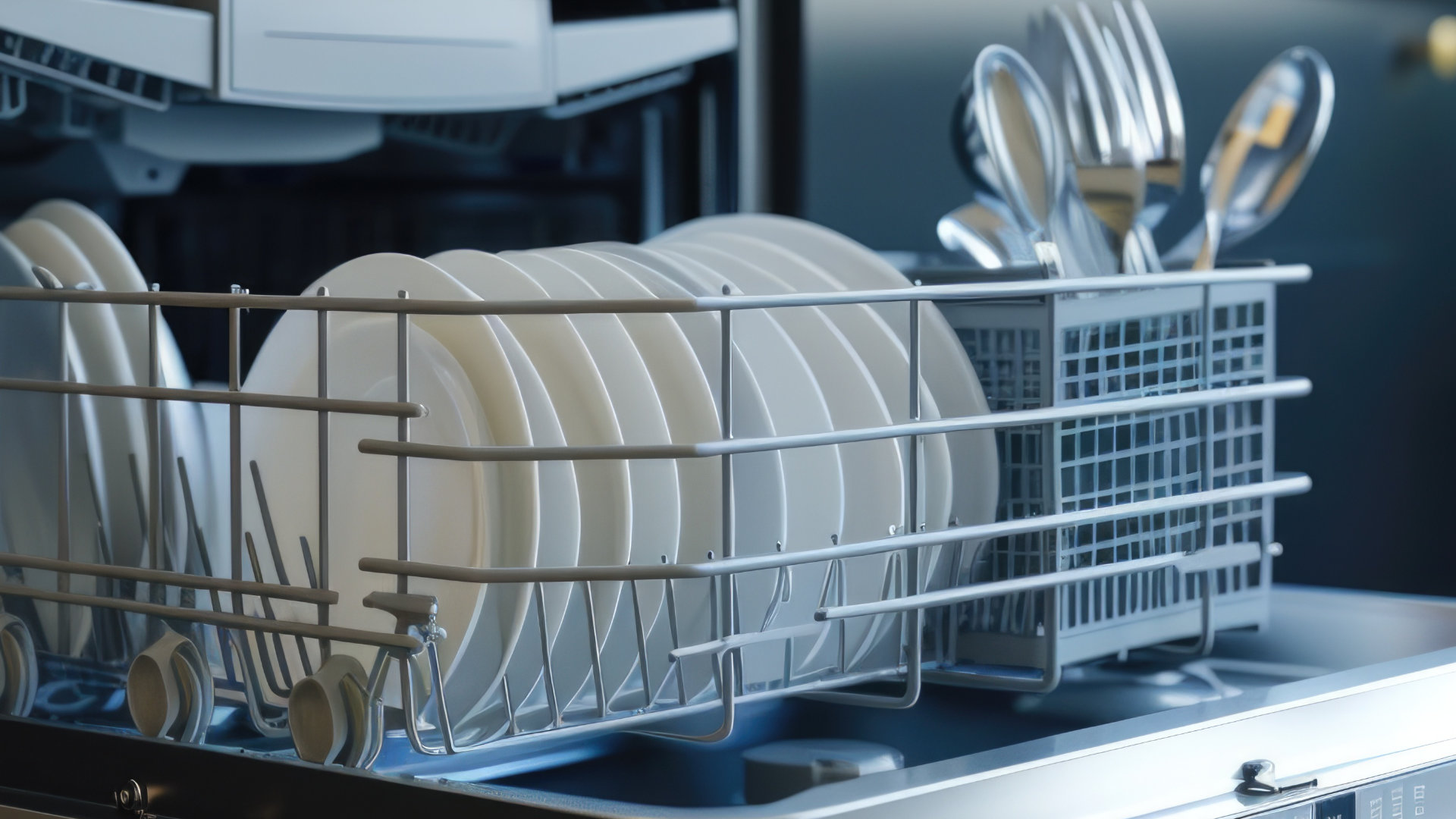
Have you noticed a sharp decline in your dishwasher’s cleaning ability? Perhaps water is pooling at the bottom, or maybe it’s not functioning at all! All of these issues can be caused by a clog preventing optimal water flow. Clogs can occur anywhere within the dishwasher but are most common in the filter assembly, the spray arms, and the drainage system. In our guide, we walk you through the five steps you need to take to clear any clogs and get your dishwasher functioning optimally. Let’s dive in!
What You’ll Need
Before you start, make sure you have all the necessary tools and products. We recommend:
- A cloth or sponge
- A small scrubbing brush or old toothbrush
- Mild detergent
- A toothpick or something similar
- Furniture dolly
- Old towels
- A shallow pan or bucket
- Your choice of dishwasher cleaner
Step 1 – Turn Off Dishwasher
This might seem obvious, but before you start, turn off your dishwasher to avoid any risk of electric shock. Make sure the dishwasher is empty of all dishes, and remove the dish racks to improve access to the filter and spray arms.
Step 2 – Remove and Clean the Filter
Probably the most common location of clogs in a dishwasher is the filter. It’s designed to trap food debris that is stuck to your dishes, but if not cleaned frequently enough it can become clogged. If the filter gets too clogged, it can even cause drainage issues and prevent your dishwasher from cleaning properly. You may start to notice food debris building up around the outside of the filter when a cleaning cycle finishes, and there may also be water pooled at the bottom of the dishwasher at the end of the cycle.
To clean your filter:
- Locate the filter. In most dishwashers, this is located at the bottom front of the dishwasher’s interior.
- Remove the filter. Some click into place, while some need to be unscrewed—consult your dishwasher manual for specifics.
- Thoroughly rinse the filter under running water until all debris is removed. If there is stubborn debris, you can soak the filter in a mild detergent for 15 minutes and then use a small scrubbing brush or old toothbrush to remove the buildup.
- Make sure the filter housing is clean and free of food debris.
- Put the filter back into its housing and click or screw it into place.
Step 3 – Remove and Clean the Spray Arms
Another common site of dishwasher clogs is the spray arms. The spray arms shoot jets of water at your dishes, helping to remove grime and food particles. Sometimes, it’s possible for food particles to get stuck within the spray arms and block the holes, preventing proper cleaning. This is particularly common if you don’t rinse your dishes before putting them into the dishwasher, and is also more likely to occur with highly fibrous food particles, like lentils or quinoa.
To clean the spray arms:
- Remove the upper and lower spray arms from your dishwasher. In most models they simply unscrew counterclockwise, but if you’re having trouble you can check your dishwasher manual.
- Check all the holes in the spray arms for clogs or blockages. If you see any, you can use a toothpick or a small piece of wire to clear them out.
- Run water through the spray arm to ensure that all the holes are clear and flowing freely.
- Replace the spray arms.
Step 4 – Check and Unclog the Drain Hose
Once you’ve cleaned the filter and spray arms, the next step is to unclog the drain hose. In most cases this will require moving your dishwasher, so make sure you either have help to move it or use a furniture dolly to avoid injury. Disconnecting the drain hose can lead to leaking of residual water, so have old towels or a bucket on hand to catch any leaks.
Here’s how to clear the drain hose:
- Move the dishwasher away from the wall to gain access to the drain hose.
- Disconnect the drain hose from the dishwasher (it’s usually held on with a clip) and remove the other end from the drain pipe. Make sure you have the old towels and bucket on hand so you don’t make a mess!
- Run water through the drain hose to see if it’s flowing freely.
- If the drain hose appears to be either partially or fully clogged, use a length of wire or a drain snake to clear the clog.
- Run water through the hose again to make sure it’s fully cleared.
- Reconnect the drain hose to the dishwasher and put it back in place in the drain pipe. Put the dishwasher back in place, ensuring that the drain hose doesn’t get pinched or kinked in the process.
Step 5 – Run a Cleaning Cycle
Once you’ve cleared all visible clogs, you can finish the cleaning process with a deep cleaning cycle. You can purchase a bottle of dishwasher cleaner from the supermarket, or if you prefer natural products you can use vinegar instead. Here’s what to do:
- Turn your dishwasher back on and put the racks back in.
- Place a bottle of dishwasher cleaner upside down on the top shelf of your dishwasher. If you prefer the natural option, place a bowl or container filled with one cup of white vinegar on the top shelf instead.
- Set your dishwasher to the self-cleaning cycle. If it doesn’t have a self-cleaning setting, choose the hottest possible cycle.
- Run the entire cycle with nothing else in the dishwasher.
- When finished, remove the bowl or empty bottle. You should now find that your dishwasher is free from clogs and is functioning perfectly. Any issues with pooling water or ineffective cleaning should now be completely resolved!

How to Unclog a Dishwasher (in 5 Steps)

How to Reset Samsung Dryer (in 5 Steps)

Why Your Dishwasher Stops Mid-Cycle

Circuit Breaker Keeps Tripping? Here’s Why

Eliminate the Burning Smell From Your Microwave

Fixing a Samsung Freezer That Won’t Freeze

Whirlpool Oven Won’t Heat: Here’s What To Do

Easy Steps to Clean Your Refrigerator Coils

Quick Fixes for an LG Dryer Not Heating

